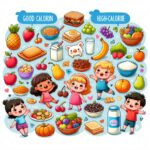Avoiding added sugars in toddler diets is a crucial step towards ensuring a healthier lifestyle for our little ones. With the overwhelming presence of added sugars in processed foods, it’s more important than ever to equip parents with practical tips to navigate this nutritional challenge. This comprehensive guide will delve deep into why cutting down on added sugars is essential and how to do it effectively.
The Importance of Reducing Added Sugars in Toddler Diets
Consuming high levels of added sugars from an early age can lead to a plethora of health issues, including an increased risk of obesity, dental problems, and type 2 diabetes. According to the American Heart Association, toddlers should consume less than 25 grams (or 6 teaspoons) of added sugars daily. However, many toddlers exceed this limit without their parents even realizing it.
It’s imperative to differentiate between natural sugars found in fruits, vegetables, and dairy products, which are integral to a nutritious diet, and added sugars that offer no nutritional value. Educating yourself on reading food labels correctly can be a significant first step in identifying and avoiding these hidden sugars.
Avoiding Added Sugars in Toddler Diets: Practical Tips
Adopting a hands-on approach to managing your toddler’s sugar intake doesn’t have to be daunting. Start by integrating whole, unprocessed foods into their diet and utilizing natural sweeteners like fruits to enhance flavor. Preparing meals at home allows for complete control over the ingredients used, ensuring that your toddler’s diet is both nutritious and delicious.
It’s also beneficial to gradually introduce your toddler to a variety of flavors that aren’t overly sweet. This can help in developing a palate that appreciates flavors beyond just sweetness. For instance, incorporating vegetables in a fun and creative way can make them more appealing to toddlers. For more tips on making vegetables exciting for toddlers, consider reading [Creative Ways to Incorporate Vegetables into a Toddler’s Diet](https://babywhysandhows.com/creative-ways-to-incorporate-vegetables-into-a-toddlers-diet).
Identifying Hidden Sugars
One of the biggest challenges in reducing added sugars in toddlers’ diets is identifying them. Many products marketed as healthy can be deceiving, containing high amounts of added sugars. Foods like flavored yogurts, cereals, and even some toddler snacks that appear nutritious can be culprits. Learning to read and understand food labels is a crucial skill for parents. Look for ingredients that end in ‘ose’ (such as fructose or glucose) and other terms like corn syrup and malt syrup, which are indicators of added sugars.
Another effective strategy is to familiarize yourself with the [American Heart Association’s guidelines](https://www.heart.org/en/healthy-living/healthy-eating/eat-smart/sugar/reducing-sugary-drinks-and-sugary-foods-for-children-infographic) on reducing sugary drinks and foods for children. These guidelines provide a solid foundation for understanding the impact of sugar on children’s health and practical ways to minimize its consumption.
By implementing these practical tips and being mindful of the added sugars in your toddler’s diet, you can pave the way for a healthier, happier future for them. Remember, small changes can lead to significant health benefits over time.













